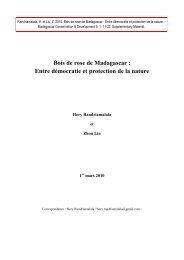Journal Madagascar Conservation - Madagascar Wildlife ...
Journal Madagascar Conservation - Madagascar Wildlife ...
Journal Madagascar Conservation - Madagascar Wildlife ...
Create successful ePaper yourself
Turn your PDF publications into a flip-book with our unique Google optimized e-Paper software.
MADAGASCAR CONSERVATION & DEVELOPMENT VOLUME 3 | ISSUE 1 — DECEMBER 2008 PAGE 35<br />
TABLE 2. Frequency of successful ‘trapping on the ground’ versus ‘1 - 2 meters above the ground’, grouped by species and site.<br />
Genus Parcel 1 (ground) Parcel 1 (tree) Parcel 2 (ground) Parcel 2 (tree) Ihazoara (ground) Ihazoara (tree)<br />
Rattus 21 31 0 2 2 3<br />
Mus 11 2 0 0 14 5<br />
Eliurus 1 0 0 0 0 0<br />
Macrotarsomys 3 0 0 0 0 0<br />
Echinops 16 0 21 0 9 0<br />
Microcebus 29 89 9 61 12 54<br />
TABLE 3. Morphometric data of nocturnal mammals at Beza Mahafaly, excluding infants and juveniles except where noted (N, mean, and, in parentheses,<br />
standard deviation)<br />
Genus and species N Body mass (g) Head length (mm) Body length (mm) Tail length (mm) Foot length (mm) Ear length (mm)<br />
Rattus 49 106 (17.6) 45.4 (3.5) 113.1 (13.7) 117.2 (25.9) 31.6 (2.5) 21.5 (1.3)<br />
Mus 30 11.7 (1.9) 24.7 (1.4) 50.3 (6.7) 70.7 (6.1) 15.3 (1.2) 12.1 (1.2)<br />
Eliurus* 1 23.0 -- 31.6 -- 55.0 -- 120.0 -- 25.0 -- 20.6 --<br />
Macrotarsomys 3 19.7 (2.9) 33.8 (1.8) 74.0 (1.7) 143.0 (34.0) 27.5 (1.3) 17.7 (1.0)<br />
Echinops 35 83.7 (5.6) 42.2 (1.3) 119.2 (17.4) 0 16.6 (0.6) 19.6 (1.5)<br />
Microcebus 154 50.7 (9.9) 33.6 (1.7) 91.9 (9.5) 144.6 (11.0) 29.5 (3.2) 22.1 (1.3)<br />
*This individual is a juvenile.<br />
DISCUSSION<br />
Macrotarsomys bastardi has a wide geographic distribution and<br />
is not considered endangered. However, it may be rare in certain<br />
parts of its range. Several other species of Macrotarsomys (M.<br />
ingens 64.5 g, M. petteri 105 g.) have a very restricted geographi-<br />
cal range; indeed, the largest of the big - footed mice, M. petteri,<br />
was only recently described on the basis of the capture of a<br />
single individual in the forest of Mikea near the west coast of<br />
<strong>Madagascar</strong> (north of Toliara) (Goodman and Soarimalala 2005).<br />
From subfossil material, we can now consider that this species<br />
also occurred in southeastern <strong>Madagascar</strong> not long ago<br />
as its bones were found in the subfossil Holocene fauna of<br />
Andrahomana, a cave in southeastern <strong>Madagascar</strong> approximately<br />
460 km away from the capture site in the Mikea forest<br />
(Goodman et al. 2006, Burney et al. 2008).<br />
Despite years of fieldwork by numerous field researchers<br />
at Beza Mahafaly Special Reserve, Macrotarsomys bastardi has<br />
never previously been reported here. Nocturnal surveys and<br />
trapping were first conducted at Beza in 2002 during the rainy<br />
season, and subsequently in 2003 and 2004 during the dry<br />
season. Rats were observed in trees as well as on the ground;<br />
in July, 2003, ER found two rats in traps set (for Microcebus) at<br />
heights of about two meters above ground within the gallery<br />
forest. Intensive trapping was later initiated in October 2006; it<br />
was continued thereafter through the end of September 2007.<br />
During that year, many rats and mouse lemurs were captured<br />
and marked, but it was only then and indeed only during a<br />
two - month interval within that period (May and June 2007 – the<br />
early dry season) that endemic rodents were also successfully<br />
trapped. At Morondava, reproductive activity of Macrotarsomys<br />
bastardi peaks in April and May (Ganzhorn 2003). It is possible<br />
that it peaks a bit later at Beza, which is located considerably<br />
further to the south (393 km); thus the captures in May and June<br />
may correspond to the breeding season.<br />
The fact that Macrotarsomys bastardi and Eliurus myoxinus<br />
were trapped in such low numbers signals their possible<br />
endangerment at Beza Mahafaly. Nevertheless, it is interesting<br />
to note that endemic small mammals do persist in small forest<br />
patches in <strong>Madagascar</strong>. It is noteworthy that Goodman et al.<br />
(1993) reported no endemic rodent presence in pellet samples<br />
of the Long - eared owl (Asio madagascariensis) collected just<br />
outside the reserve at Beza Mahafaly on the bank of the Ihazoara<br />
River during the year 1990. Pellet samples were collected<br />
during both wet and dry seasons (March, April, June and November).<br />
In contrast, at Bezavona (near Nahampoana, in southeast<br />
<strong>Madagascar</strong>, near Taolognaro), bones of two species of Eliurus<br />
(along with introduced rodents and other small mammals) were<br />
found in the pellets of the same owl, so it is unlikely that these<br />
rodents are unattractive to this formidable predator.<br />
One of the factors that may influence capture frequencies<br />
is variation in diet. However, many rodents are attracted to<br />
banana, and should be lured by traps baited with banana. Rats<br />
and mice consume fruit as well as seeds, insects, and leaves,<br />
and both readily enter traps, particularly when set at low levels<br />
or on the ground. Macrotarsomys bastardi is strictly nocturnal<br />
and terrestrial, and similarly feeds on seeds and fruit (Carleton<br />
and Goodman 2003, Ganzhorn 2003).<br />
Incidentally, Cheirogaleus medius has been listed as<br />
present at Beza Mahafaly (e.g. Mittermeier et al. 2006), but<br />
this is likely an error. This species has never been observed<br />
by researchers working on nocturnal mammals at Beza; bones<br />
of this species have not been recorded in owl pellets (largely<br />
Microcebus; see Goodman et al. 1993), and no Cheirogaleus<br />
entered traps set at any height during this study. It is unlikely



